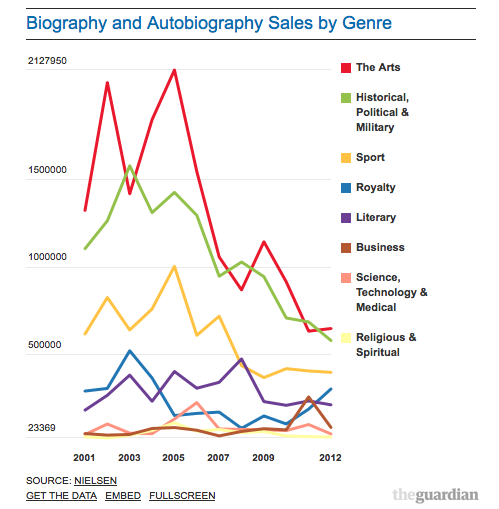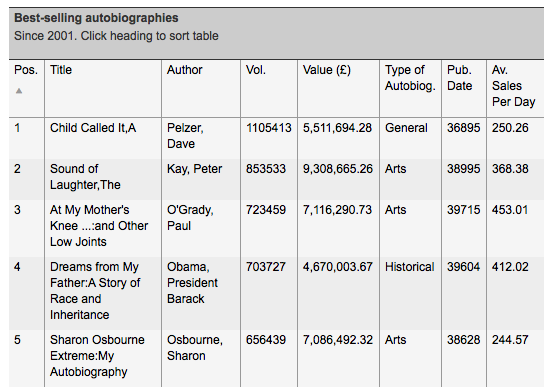As I was flipping through my ASTU notebook, I stumbled upon a couple of questions that I jotted down about a month ago during our discussion about autobiographical narratives. At the time, we were talking about how some life stories receive attention from the global community, while others remain silent. The question that I would now like to return to is this: “What kinds of life narratives become best-sellers and how can they affect others?”
While I was researching online, I came across a set of data posted by The Guardian that plotted the best-selling (auto)biographies since 2001. Although autobiographical work only made up a small percentage of book sales in 2012, it interesting how life narratives were at their peak of sales in 2001 and 2005. This set of data indicates several things. First, the genre, Arts, consistently remains at the top of all autobiographical book sales. Second, autobiographical book sales were at its highest during the years of 2001 and 2005. Lastly, after 2005, there has been a dramatic drop in the sales of autobiography. See below:
 How can we can make further sense of this data? In the article, Conjunctions: Life Narratives in the Field of Human Rights, Schaffer and Smith note how Post-WWII global transformations have led to an increased interest in the production of autobiography and concern over human rights. The first half of the new millennium were full of global conflicts and transformations; the early 2000’s also saw various wars begin and end, coup d’états, and other crises that should have resulted in a greater proliferation of life narratives about such global events. If there is a greater production and interest in autobiographical work (especially in the genre of Arts) during times of conflict, then it should explain why book sales in the early 2000’s were significantly higher, right?
How can we can make further sense of this data? In the article, Conjunctions: Life Narratives in the Field of Human Rights, Schaffer and Smith note how Post-WWII global transformations have led to an increased interest in the production of autobiography and concern over human rights. The first half of the new millennium were full of global conflicts and transformations; the early 2000’s also saw various wars begin and end, coup d’états, and other crises that should have resulted in a greater proliferation of life narratives about such global events. If there is a greater production and interest in autobiographical work (especially in the genre of Arts) during times of conflict, then it should explain why book sales in the early 2000’s were significantly higher, right?
Apparently not. I was quite surprised when I came across this next set of data detailing the 50 best-selling autobiographies since 2001. Here are the top 5:
Looking through this list, I notice that only one of the top 5 best-sellers is explicitly about trauma, specifically, child abuse. Somehow, our studies in ASTU class led me to believe that books explicitly about trauma and bearing witness, such as Persepolis and What is the What, would widely popular, and possibly best-sellers. However, as I scroll through the list of the top 50 best-selling autobiographies, I realize that a majority of these books are written by and catered to a predominantly “Western” audience. Judging from the book sales, minority narratives, particularly from the East, do not not have as great of a sale reception compared to narratives written by the West. Therefore, life narratives from the periphery may not be as widely distributed and consumed as we may think. This raises the issue of how consumers of life narratives may be neglecting the voices that are demanding to be heard and silencing accounts that speak about personal experiences such as trauma, oppression, and human rights abuse.
So now I end with even more questions: Are our priorities being shifted by those who control the book markets? How can consumers realize that their purchasing decisions they may be neglecting the voices that desperately need to be heard? Why has there been a decrease in the sales of autobiographies in the last few years, considering the tumultuous events that have occurred? What can we do about all this? Let me know what you think!

